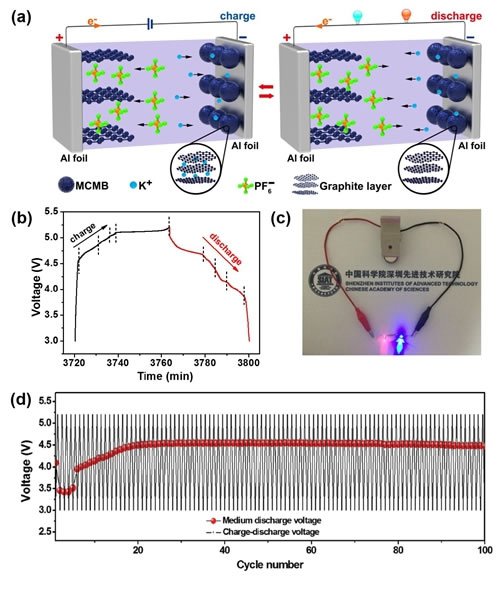Shenzhen Advanced Institute develops new low-cost dual-carbon potassium ion battery technology

Fig. (a) Schematic diagram of battery structure and reaction mechanism, (b) Charge and discharge curves of the battery, (c) Macro photograph of two LED lamps illuminated by a single button cell, (d) Discharge voltage median stability curve.
Recently, Tang Yongbing, a researcher at the Institute of Functional Thin Film Materials, Institute of Advanced Technology, Shenzhen Institute of Advanced Technology, China, and his research team have successfully developed a new type of high-performance, low-cost dual-carbon potassium ion battery. Related Research Results A Dual-Carbon Battery Based on Potassium-Ion Electrolyte (K-DCB based on potassium ion electrolyte) has been published online in Advanced Energy Materials.
Lithium-ion batteries have been widely used in portable electronic devices, energy storage devices and other fields. However, as lithium-ion batteries are gradually used in smart phones, electric vehicles and other fields, the demand for lithium is rapidly increasing year by year. The global reserves of lithium are very limited and unevenly distributed, causing the raw material prices to rise rapidly, which seriously restricts the cost of our country's low cost. The rapid development of high-performance energy storage devices. Potassium has a similar physical and chemical properties to lithium, and its abundant reserves, low cost, and lower redox potential than sodium, making potassium ion-based secondary battery systems have received widespread attention. In addition, in recent years, dual carbon batteries have been widely used in the industry due to their low cost and high operating voltage due to the use of environmentally friendly and inexpensive graphite materials for their positive and negative electrodes.
Combining the respective advantages of potassium-ion battery and dual-carbon battery, Tang Yongbing and his team members Ji Bfa and Zhang Fan successfully developed a new type of high-performance, low-cost, environmentally friendly dual-carbon potassium ion battery. The battery uses a mesophase carbon microsphere as a negative electrode and an expanded graphite as a positive electrode. The electrolyte uses a cheap and readily available potassium hexafluorophosphate as a potassium salt electrolyte dissolved in an organic solvent. The reaction mechanism is as follows: During charging, the potassium ions in the electrolyte move to the negative surface of the mesocarbon microbeads and are embedded into the graphite layer. At the same time, the hexafluorophosphate anion is intercalated into the positive graphite; during discharge, the potassium ions are from In the negative graphite layer, the hexafluoride phosphate in the positive graphite desorbs into the electrolyte.
Research shows that the new low-cost dual-carbon potassium ion battery has a median discharge voltage of 4.5V. A single coin cell can light up two LED lamps at the same time. After 100 cycles of charge and discharge, the capacity is almost not attenuated, making it possible to Meet the requirements of high voltage devices. Compared with the existing traditional lithium-ion battery technology, the new battery will greatly reduce production costs, but also has the advantages of environmental friendliness, high security, relatively high energy density, etc., so in the field of large-scale renewable clean energy storage, communications backup power and other fields Has a wide range of application prospects.
The study was funded by the National Natural Science Foundation, the Guangdong Provincial Innovation Research Team, the Guangdong Provincial Science and Technology Plan Project, and the Shenzhen Science and Technology Plan Project.
Hydraulic Fittings connect conductors such as hoses, pipes and tubes in a hydraulic system. Most tube fittings have a male and female component that join to form a connection. These hydraulic connections help contain and direct the flow of hydraulic fluid in the conductor while preventing leaks and maintaining pressure. Different hoes end fittings allow designers to change flow direction, the elevation of lines or split flow. Crimping is the most common method for assembling hoses and fittings. Hydraulic Hose Fittings are made of many different materials including stainless steel, brass, plastic, Monel and more. Not always, but often fittings match the material of the conductor used in a system. This multitude of materials creates fittings with a wide array of performance capabilities.
Our Hydraulic Adapter products include a wide range of standard : Eaton standard, Parker standard, American standard ,custom, and jump size fittings from 1/8" to 2" in materials such as carbon steel, mild steel, stainless steel fitting, brass, aluminium, plastic and so on. Virtually any straight or shape style fitting whether tube fitting, pipe fitting, or swivel adapter can be machined in NPT, JIC, ORFS, BSP, BSPT, BSPP,or S.A.E. thread forms and all are REACH and RoHS compliant in surface treatments.
Hydraulic Fittings,Hose Connectors,Hydraulic Hose Fittings,Hose Pipe Connector
SHIJIAZHUANG TOPA TRADING CO., LTD. , https://www.topahydraulic.com